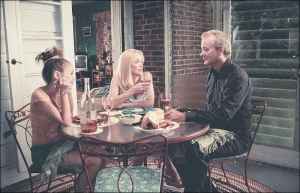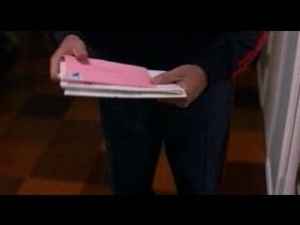Broken Flowers (2005) and Ambiguity: The Need for Active Viewers
Ambiguity in cinema results in different reactions depending on active or passive viewers. Passive viewers who prefer information clearly stated through dialogue and visuals hate ambiguity, whereas active viewers thrive on ambiguity, implementing their own interpretations on a film. Broken Flowers is one example, telling Don’s story of introspection as an aging bachelor, who is sent a letter revealing he has an adult son from an anonymous ex-girlfriend. Micheal W. Phillips notes Broken Flowers is “about questions, not easy answers, and its refusal to provide them might frustrate some viewers unaccustomed to Jarmusch’s elliptical style” [1]. Broken Flowers leaves viewers with more questions than answers due to an ambiguous narrative that only active viewers will be able to decipher.
Characters’ Expressions

Ambiguous films require viewers to be active in understanding their content. Passive viewers will overlook a character’s expressions if, for example, a scene is edited between characters within a couple of seconds. This does not matter for active viewers, as they know any observations will be significant. Active viewers that observe a character’s expressions with a deep sense of focus will make ambiguous films work, as opposed to passive viewers who only acknowledge what is on the surface.
After Don reads the letter informing him about his son, he is persuaded to visit numerous ex-girlfriends. Don talks to himself before visiting Laura, the first ex-girlfriend. “Look for clues”, he repeats. Don’s repetition of “look for clues” motivates viewers to place themselves in Don’s position, to become inquisitive of any clues. Don asks Laura if she owns a typewriter, which was used to type the letter. Don focuses on Laura’s reaction, seeking any expression which may indicate she wrote the letter. Viewers, like Don, have to pay close attention to Laura’s reaction in solving the mystery. Viewers focusing on characters’ expressions is repeated in Don’s awkward reunion with Dora, the second ex-girlfriend. Dora is standoffish and uncomfortable with Don, meaning active viewers could read Dora’s expressions as secretive. However, it could be the passing of time that has made Dora regret the part of her past in which Don is included. Passive viewers might see Broken Flowers as an emotive drama, yet active viewers can form possible interpretations of the narrative’s mystery.
Use of Dialogue

Dialogue within any film is important to represent a character’s personality. Yet dialogue also contains indications which solve mysteries within ambiguous films. Passive viewers will simply take dialogue for granted, accepting everything a character said without any underlying meaning. Active viewers are able to detect underlying meanings, as they hold cryptic clues in solving a narrative’s mystery. This is another method which reflects the impact of ambiguous films depending on active or passive viewers.
“It’s very strange, you showing up like this”. Dora’s use of language during Don’s visit comes across as an emotive drama, yet active viewers can interpret Dora’s use of language differently. Since Don is searching for the mysterious ex-girlfriend, active viewers could assume Dora is defensive, as she might feel her secret (if any) will be unraveled. Yet there could be other reasons unrelated to Don’s search. Interpretations of Dora manifest during a dinner conversation between herself, her husband and Don. The topic of children turns awkward as Dora’s husband states she never wanted children with him. Active viewers could interpret Dora not wanting children with her husband due to conceiving Don’s lovechild. Whether this interpretation is right or wrong, it makes Broken Flowers a fulfilling film which strives on ambiguity.
Symbolic Clues

Symbolic clues in films need to be understood if any ambiguity will be resolved. Passive viewers may simply refuse to contemplate symbolism or will be unable to link symbolism towards the narrative. Active viewers are able to relate symbolism towards the narrative through interpretations. Whether these interpretations are right or wrong, active viewers at least have the ability to make ambiguous films work. Without the ability to form interpretations, the impact of ambiguous films will be minimal at best.
There are various pink items throughout Broken Flowers, alluding to Don’s search for the mysterious ex-girlfriend. Broken Flowers‘ opening scene shows a pink envelope being delivered to Don’s letterbox. The pink envelope has great importance to the narrative, becoming Don’s catalyst for solving the mystery. Whether it is Laura’s nightgown, Dora’s business card or Penny’s typewriter (strongly hinting she is the mysterious ex-girlfriend), pink always engages Don’s mind which should also make viewers active. After Don’s search, he meets a young traveler (credited as The Kid) who he suspects could be his son. Don notices a pink ribbon on The Kid’s bag after The Kid states his mother placed it there, which should spark interpretations. The pink ribbon’s connection to recurring symbolism in Broken Flowers makes viewers continuously active, which is vital in engaging its content.
Unresolved Narrative

Broken Flowers’ narrative remains unresolved, adding to its ambiguity. Passive viewers will feel underwhelmed and possibly annoyed by the narrative’s lack of clarity. However, active viewers will strive on their general interpretations of Broken Flowers‘ narrative. This contrast between active and passive viewers emphasises the need for active viewers to enjoy ambiguous films, or else a narrative’s meaning will be unfulfilled.
Broken Flowers‘ final scene is Don trying to bond with The Kid. After Don states he knows (at least in his opinion) that The Kid is his son, the latter is scared off and runs away as Don vainly attempts to catch up. Don is left standing alone in the street when he stares at a car passenger glaring back at him, hinting he may be Don’s son. These two moments leave Don in a confused state of mind. The ambiguity of the final scene is left for viewers to interpret, as Don has not resolved the identities of his mystery ex-girlfriend or son. Active viewers have to determine if The Kid really is Don’s son, is it the car passenger or are they both red herrings? Without forming these interpretations, Broken Flowers will remain ambiguous instead of meaningful.
Broken Flowers and its ambiguous narrative needs active viewers, or else it will suffer. Through various visual clues and specific pieces of dialogue, Broken Flowers offers active viewers a narrative where all interpretations are open in solving the mystery surrounding Don’s ex-girlfriend and son. It is highly important for all viewers to be active whilst watching Broken Flowers, as any interpretations will give the film poignancy, a poignancy nonexistent with passive viewers.
Works Cited
Phillips., M.W. 2005. Broken Flowers. Goatdog.com. [Online][Available From] – http://www.goatdog.com/moviePage.php?movieID=784
What do you think? Leave a comment.











I’m a big Bill Murray fan, I could watch him read the phone book and enjoy it, but I mean he’s got to READ the phone book. Watching him STARE at the phone book pushes the point it to far…
I get it, he’s “droll” and “dour” and amazing at doing very little, but he can’t take it to ridiculous lengths. I mean watching Bill Murray sleep and saying it’s brilliant, is just asking for someone to say “the emperor’s got no clothes”.
i think he might be laughing to himself already, and saying “watch me just do absolutely nothing and everyone will say I’m a genius and this is the performance of my career”
i don’t think it’s boring but overall i found it pretty average as it’s not a movie ill see again and like i always say re-watch factor is what ultimately makes or breaks a movie in the long term as all of the truly great movies hold up on re-watches as the years pass.
with that said… there are some movies i see here and there that i am bored from to the point i can’t finish which makes those movies pretty much as bad as movies can get since boring is the polar opposite of enjoyment/entertainment which is the #1 area a movie must succeed.
p.s. for the record… this is the 4th movie i have seen from the director which are Dead Man(1995)/The Limits of Control(2009)/Only Lovers Left Alive(2013-2014)/Broken Flowers(2005). i am pretty sure i seen them in that order to as i just seen Only Lovers Left Alive yesterday (Aug 17th) and then Broken Flowers(2005) today (Aug 18th) and i seen The Limits of Control (2009) back on Aug 4th 2012. i seen Dead Man (1995) sometime before that and had to be sometime before Dec 27th 2011 since from that date on forward i been keeping a log of all movies i see. i should get around to re-watching The Limits of Control (2009) to see how it is on a re-watch. but i imagine some people will see that movie more like “The Limit of Patience” (lol) ; as it’s pretty slow paced and some people might see it as boring. hence, testing their patience to continue watching the movie
Neat analyses. Some of the dialogue was interesting, and it was a film that didn’t give many answers and left you wondering what was next.
Thanks Boyce
Didn’t like it. It was actually worse than Lost In Translation.
Really? I enjoyed Lost in Translation, A great character study.
I really enjoyed your analysis.
I am a sucker for a summer blockbuster but I absolutely love character driven films that demand the viewer to interact.
And honestly, I’d watch Bill Murray mow his lawn if it was on screen.
Thank you Jamie
Hey Ryan. I really like the way the article turned out. Great job with everything, and I will try to catch this film sometime. Take it easy!
Thanks for all your help Danny, I appreciate it.
It’s a little puzzling to me why he would go about in such a roundabout way finding out if he has a son. He traveled hundreds of miles and all he asks his ex’s is whether they have a typewriter etc.
Considering he got a letter addressed to him why not ask them if they were the ones who sent him the letter? It’s a tad absurd going about it this way.
This is another desperate attempt by hollywood to create an intellectual film with a high standard of art. We throw away so many of these films in europe that you wouldn’t believe!
The surprisingly high praise for “Broken Flowers” that I have read online is a pretty representative example of nihilism as a form of art enjoyed by little chapels (virtual, sometimes, real) of enlightened few basking themselves in the hazy bleakness of nonsense. True, an ending like this may contain a lot of potential interpretations but when the viewer’s mind feels violated (or raped), as mine did, it is because something is missing. “Less is better” is a school of creation with its merits, and I concur to it myself very often, but that attitude towards art should not equate with “everything and anything goes”, otherwise should we not brace ourselves for the worst in the name of art?
Seriously, the ending is not bad per se, it is only … facile and complacent. It felt as though the director deliberately meant to frustrate the viewer by leaving him/her too suddenly and without any GOOD clue to the love affair that he/she just had with an otherwise pleasant “road trip” type of movie.
In a way, I felt exactly as I once did after being left without any explanation by a woman whom I saw again (just like Don) 31 years later, and who presented pictures of …. my unknown child and his three children to me !!! True story. It was a immense relief, because I had had no clue to the reason she had left me 31 years ago, having herself denied being pregnant at the time (but she was!!). Notwithstanding all the blessings of adding another child to my family and becoming grandpa, I still feel anger towards her (as our son does to) for not having let me know the truth.
Back to the movie, a similar lesson applies. It’s all right with me to crafting works of art that raise questions or that are not plain or literal, provided that there are enough clues to understand the artist’s purpose or vision. Like a good detective novel should provide enough clues to reconstitute the actual causes and circumstances of a crime. Otherwise, the artist actually rejects his/her fellow humans.
But of course, works of art can also be made for oneself only, and sadly, the ending of “Broken Flowers” evokes that possibility for me, at least…
I just watched this an feel exactly the same way about the type of people who clap and say “bravo” over a film like this. I know it’s judgmental but I can’t help but think they are only pretending to find it deep, meaningful, and moving because they’re to embarrassed to admit they don’t get the point. Myself, I don’t think there was a point and the ending did make me angry at the writer.
Crazy story about your son — why would a woman DO that? I’d be pissed at her too. Glad you found out about him eventually though.
I think this movie could have been done better.
How so Jasper?
I thought the female roles were interesting and funny, providing excellent opportunities for some fine actresses.
I like ambiguity in films from time to time. It’s a nice break from the loud, action packed blockbuster or romantic comedy. I know many people hated it, but I really liked the ending to No Country for Old Men. Even though the movie was some what of an “action” film, the ending lent to the deeper meanings behind the violence and chaos. It was ambiguous and left the audience to decide what it all meant.
I’m a huge fan of Bill Murray, yet I have never seen “Broken Flowers,” but now I’m looking forward to checking it out. Great analysis!
Thank you Amanda
Bill… where is Ghostbusters 3?
Hey Ryan, nice job with the article. I really like your analysis of the active vs. passive viewer. Kind of reminds me of my mom and myself. Don’t get me wrong, I love my mom, but when we watch a movie together she wants everything served to her on a plate while I thrive on the fine details of the film. Every good movie can’t waste film. I love a movie where every single shot contributes something to interpretation.
I like the way you break down active analysis into the different forms: expressions, dialogue, symbols. I think more could be added to this list. Camera angles or light filters for example. I recently watched the movie “Nebraska” (excellent). I think many people may have been turned off by the black and white film but I believe it takes an active viewer to try and determine a reason for it. Personally I think it’s a representation of old age. Something the film captures beautifully and humorously.
Thank you Greg, I appreciate your comments. Like you, I am someone who likes to be an active viewer. I recently saw Twin Peaks in its entirety and Twin Peaks: Fire Walk With Me. They are certainly works which engage the mind.
While I can understand the ambiguity, I feel like an active/passive viewer could still view this film as a character study based on his interactions with his exes.
Excellent point; the movie works very well as a simple character study. That’s basically how I saw the film when it first came out. It’s only having seen it again that I appreciate the nuances and ambiguity that the author of this article praises.
There is another film by Jim Jarmusch that is one of my favorites. It is called Coffee and Cigarettes. Bill Murray makes an appearance in this movie also. I have shared it with many people and noticed that some are just as enthralled while most end up getting up and walking away during the movie. After reading your article on active and passive viewers I now have a better understanding as to what was going on our movie viewing brains.
I saw Broken Flowers several years ago (at least twice), and after the second time around I came up with an alternate theory on the sender of the letter in the pink envelope. In the beginning of the movie we meet Don’s, apparently only, friend who stirs up Don’s interest in the letter and encourages him to track down the sender. I wonder if his friend, the one with the full life, wrote the letter and sent Don on a journey. This was his way of giving to his friend Don a drive for life as he searches for life (child) he created and only just found out about. I like how the ending made me foresee into Don’s future, how this event in his life will keep him constantly wondering about any young man he spots that reveals any slight resemblance or clue to his possible son.
Enjoyed your article, Ryan, thanks for writing about this incredibly underrated film.
This was a well-written and insightful article so thanks for posting it.
As constructive criticism, I wanted to say you used the phrase “active/passive viewer” entirely too many times.
I just saw this movie (9/2015). I am definitely a passive viewer. I usually love Bill Murray but to me I found the movie interminably slow, uneventful, and the inconclusive ending struck me as pointless and yes, irritated the heck out of me.
So much so that I came to the internet just to see what the movie was even supposed to be about.
I thought it would be him learning life lessons but he didn’t seem to evolve at all through the movie. Of course I wasn’t “looking” for clues, I was “waiting” to be entertained….
I’m with you Emileelee. My wife and I wasted 2 hours of our life on this film. With two little kids, we’re usually looking to be entertained by the movies we watch. And yeah, why didn’t he just ask the ex-girlfriends if they were the mother? Who wouldn’t ask that? I think people are really are pretending to like the movie so they can call themselves “artsy”.
Overall Grade: D-
I liked this film. Yes It had a slow pace to it, and the ending was frustrating, but over all I enjoyed seeing little snippets of his ex’s lives, each character is so focused upon and there are so many little details in each scene that I have come back to this film throughout the years as a nice change of pace, deciding and discovering new perspectives each time. It’s a rainy day hot cup of coffee alone time film to be enjoyed on a day off.
Jim from the future here:
I just rewatched this movie on cable, and enjoyed it even better than when I saw it when it first came out. It’s one of those movies where you notice new things on multiple viewings.
I think I’ve figured out who sent the letter. First off, in the opening scenes we see the pink letter making its way to Don’s house. This includes a trip on a U.S. mail airplane. So, the writer clearly lives in another city. This eliminates Winston (the neighbor) and Cherri (the Julie Delpy character).
That basically leave the four women Don visited. Three of the women didn’t recognize Don immediately, indicating that they hadn’t thought about him in years and needed to check their memory banks to remember who this stranger was. The true letter-writer would have had Don on her mind recently, and would have recognized him easier. Only the Jessica Lange character had no trouble recognizing Don. It was she who sent the letter.
Interesting writeup. I didn’t know about passive vs active viewers before. I’m glad I’m an active viewer, at least I was during this film. Jarmusch’s dropping of constant hints drew me that direction perhaps.
FWIW: The kid in the car, at the end, is played by… Bill Murray’s son in reality. Take from that what you will. At least it explains the striking resemblance. Source: imdb trivia.
I was left wondering at the end of the movie what the heck just happened here.
You know what?
Thanks Bill, as usual, you still are a great actor and I love you! Great cast, interesting characters. Maybe you should do a sequel? LOL
I just watched ,”Broken Flowers,” it was labeled a comedy but I found nothing comical about it. It was dark and sad, artsy in that you the viewer had to come up with your own answers. The “clues” were right in your face and no reason to watch the movie a second time. As much as I love Bill Murray, it was a waste of time for me and four good actresses.
The best use of ambiguity would be where it advances the plot and where the possibilities in ambiguity are broadly clearly defined.
I think it was rather obvious Dons current girlfriend sent the letter. The letter she wrote on pink stationary with a pink envelope at the end saying she still loved him just made it obvious. Also, in the first scene in the movie you clearly see her moving the mysterious letter to the top of the pile of mail and remarking on it, to draw his attention to it. There never was a kid. She obviously could not have foresaw his buddy sending him on a cross country trip, but she obviously did want to wake him up that his passive life and how he was needed to change. It also called attention to his obviously love ‘‘em and leave ‘em lifestyle he had when young that she probably knew about. Their argument at the start also was about whether he even wanted a family and this gambit was done to get him to think about that.
The road trip was basically little scenes with great actresses in little vignettes showing what his life choices wrought with prior women in his life. He also clearly visited them in the order which he thought he would be the most positively received. If any of them wrote the letter I think they would have knew why he was there and just admitted it. None of them did. The first played by Sharon stone was clearly a fling that she had positive memories of and was a white trashy party girl with clearly only a daughter and frankly was not the type of person to write such a literary heartfelt letter about “life journeys”.
The second Dora clearly was in love with Don( she is wearing pearls he bought her and the photo they had when young was taken by him) but trapped I a bad marriage and they said she had no kids. If she did her husband would have know why he was there as I could not see her hiding who the father was.
The third by Jessica Lange was clearly now a lesbian who did not like Don, or more likely the type of guy he represents that she dated before going lesbian. She said she had no kids and I doubt she would lie since she did not like him. And she was clearly confident and not a game player.
And the last by Tilda Swinton was so damaged and full of rage she never would have written such a letter to Don. He probably cheated on her and she hates him. Her reaction to me lead me to believe she did have a son but something awful happened to him ( probably dead) and she was enraged this guy was even asking about him.
All the pink “clues” weee just red herrings.
This is a difficult movie I admit, but the clues were there if you paid attention.